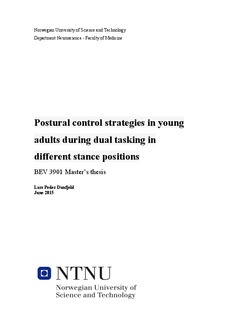| dc.description.abstract | In everything we do, we need to have control over our body’s position in space.
Traditionally, postural control is assumed to need few attentional resources that are
directed instead to other ongoing tasks. Changes in postural control while conducting
a concurrent cognitive task compared to a baseline level of performance is referred to
as dual task interference. The aim of this study was to investigate the effect of dual
tasking on postural control with the following specific question: Does the type and
magnitude of postural control movements depend on the difficulty of concurrent
cognitive tasks, the level of difficulty of stance position, or both? Participants
performed three different difficulty levels of counting (counting backwards in 1s, 3s
and 7s) during two different challenges to postural control (standing with feet hipwidth
apart or close together). Data collected consisted of force plate measurements
and 3-dimensional motion capture. Analyses focused on Centre of Pressure (CoP) and
Principal Component Analysis (PCA), respectively. PCA identified four important
categories of movements: postural movements, breathing movements, head
movements, and multi-segment movements. Stance position, but not dual tasking
affected the CoP measures. In contrast, PCA was capable of detecting significant task
effects on principal velocity and principal acceleration, and some task effects on
principal movements. Furthermore, there was a tendency for higher order PCs to be
more sensitive to changes in task than lower order PCs. The latter, especially ankle
and hip movements dominate CoP measures. In conclusion, stance position
influenced postural control as indicated by changes in CoP measures, but the latter
were not sensitive to cognitive dual tasks. In contrast, PCA clearly distinguished
single task from different levels of counting, even from single task to simple
backwards counting in 1s, especially with respect to principal velocity and
acceleration. | nb_NO |
